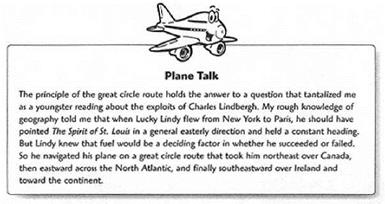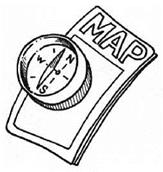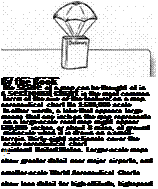Dead Reckoning: Safer than it Sounds
Armed with an aeronautical chart, a firm grasp of latitude and longitude, and a clear distinction between the true and the magnetic poles, it’s time for a glimpse of the way pilots navigate.
Most modern planes come with sophisticated electronic navigation systems, called “inertial navigation,” which use extremely sensitive motion detectors. Others use a network of space satellites to help the pilot determine his airplane’s position around the globe. The cockpits of modern airplanes are becoming crowded with all sorts of “flight management” hardware, computerized gadgets updated electronically on occasion. Some depict the airplane’s flight path in relation to a background that looks exactly like a sectional chart or another type of chart.
|
By the Book |
Gyroscopes зге spinning wheels usually made of metal that, once they start rotating in a particular position, tend to resist disturbance. In obedience to Newton’s laws of motion, a gyroscope that starts spinning in a north-south orientation, for example, will tend to remain lined up north and south. As the airplane turns, the directional gyro notes the difference between the direction the airplane is pointed and the gyro’s north-south orientation, and depicts it on the face of the instrument as a heading.
But the most “retro” navigational technique, and the one that demands the most skill from a pilot, is dead reckoning.
Dead reckoning was first used by the ancient mariners who plied the waters of the Mediterranean Sea. Those sailors knew that if they headed in a particular direction at a set speed for a precise amount of time, it would be easy to calculate how far they had traveled. For example, if a ship left shore and traveled at a speed of 10 knots in a northward direction, after one hour it would be 10 nautical miles north of port.
In theory, dead reckoning is a relatively simple form of navigation for a pilot to use. A pilot flying over the earth at a certain speed and direction for a specific time could, with a simple calculator, a protractor, and an aeronautical chart, easily deduce his position in, say, an hour. But, as in everything else, real-life conditions make such “simple” navigation a little more complicated.
|
|
Plane Talk
The origin of the phrase "dead reckoning’ is lost in the mists of time, and there is still disagreement about it among pilots and navigation experts. The lamest explanation I’ve heard is that it derives from the nautical practice of navigating by referring to objects that were ‘dead in the water.’ The most likely origin of the phrase is from ‘deductive’ reckoning which means deducing your position based on a senes of observations.
|
By the Book |
Unlike the rest of us, pilots don’t use statute miles (the common miles) in measuring distance. Instead, pilots use slightly longer nautical miles, perhaps because early flyers felt a kinship with seafarers. A statute mile, which got its name from a 1593 British statute that set the length of the modern foot, is 5,280 feet long. A nautical mile is defined as one minute of geographic arc, or 6,076 feet. That means speeds measured in nautical miles per hour, or knots, are faster than speeds measured in regular miles per hour. In fact, 100 knots is equal to 115 m. p.h.


























